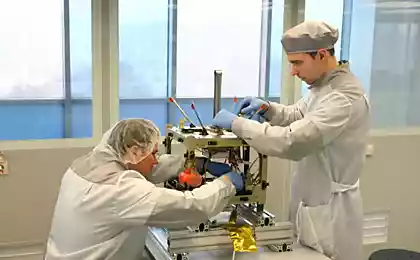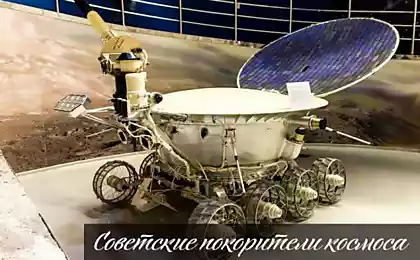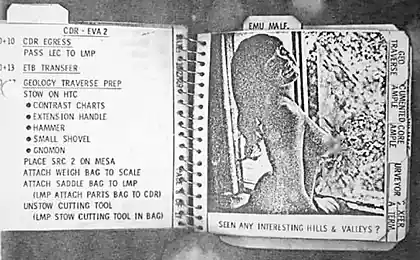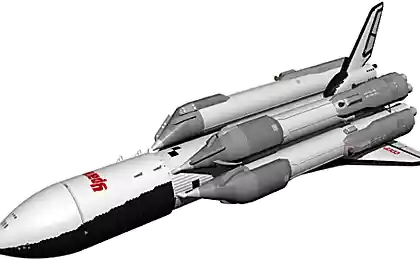924
On the outer heat and cold
On hot summer days, it's time to talk about the heat and cold of space. Due to the sci-fi movie, scientific and not so scientific and popular programs, many stuck belief that space - it's incredibly cold place where the most important thing - to find how to keep warm. But it is actually much more complicated.
Photo cosmonaut Pavel Vinogradov i>
To understand the heat or cold in space, we must first go back to the basics of physics. So, what is the heat? The concept of temperature applicable to bodies whose molecules are in constant motion. Upon receipt of the additional energy, the molecules begin to move more actively, and the loss of energy - more slowly.
This fact implies three conclusions:
1) at a temperature no vacuum;
2) in a vacuum there is only one way to heat - radiation;
3) the object in space is actually a group of moving molecules, can be cooled by ensuring contact with a group of slow-moving molecules or heat, ensuring contact with the fast-moving group.
The first principle is used in a thermos, where the vacuum wall to keep the temperature of hot tea and coffee. Similarly, transport of liquefied natural gas tankers. The second principle defines the so-called external heat transfer conditions, ie, the interaction of the Sun (and / or other radiation sources) and spacecraft. The third principle is used in the design of the internal structure of the spacecraft.
When people talk about the temperature of space, they can mean two different temperatures: the temperature scattered in space gas temperature or body in space. As everyone knows, the vacuum in space, but this is not true. Almost all the space there is, at least in galaxies full of gas, it just so much rarefied that does not have almost no thermal effect on the body is placed in it.
In the rarefied outer gas molecules are extremely rare, and their impact on the macro body, such as satellites and astronauts, slightly. This gas can be heated to extreme temperatures, but because of the rarity of molecules, space travelers will not feel it. Ie for most conventional spacecraft and ships it does not matter what the temperature in interplanetary and interstellar medium: at least 3 Kelvin, though 10,000 degrees Celsius.
What is important is what it represents our cosmic body, which is the temperature, and which sources of radiation to eat nearby.
The main source of thermal radiation in our solar system - the sun. And the earth is quite close to him, so in Earth orbits is very important to set up "relationship" of the spacecraft and the sun.
Most often man-made objects in space trying to wrap up in a multi-layer blanket, not giving away the heat of the satellite into space and do not let the sun's rays to roast delicate innards of the machine. Laminated quilt called SVHI - screen-vacuum insulation, "gold leaf", which is not really gold and foil, and coated with a special polymer film alloy, similar to the one in which the wrapped flowers.
However, in some cases, some manufacturers SVHI not like the foil, but performs the same insulating function.
Sometimes some of the moon's surface specifically left open to them or absorb solar radiation, or taken to a warm space inside. Typically, in the first case the surface is coated with black enamel, strongly absorbing solar radiation, and the second - white enamel, highly reflective rays.
There are times when the spacecraft instruments must operate at very low temperatures. For example, the observatory "Millimetron" and JWST will observe the thermal radiation of the universe, and for this and mirrors their onboard telescopes and receivers of radiation must be very cold. On JWST primary mirror is scheduled to be cooled - 173 degrees Celsius, and "Millimetron" - even lower, to - 269 degrees Celsius. To the sun does not heat the space observatories, they hide the so-called radiation screen: a kind of multi-layered parasol, like SVHI.
By the way, just for such "cold" satellites becomes important little heat from the rarefied gas of space and even fills the entire universe of photons of the CMB. Partly for that reason, that "Millimetron" that JWST is sent away from the warm Earth Lagrange point, for 1, 5 million km. In addition to solar umbrellas on these scientific satellites will be a complex system with radiators and multi-stage refrigerator.
On the other, less sophisticated devices dumping heat into space also carried out by radiation from the radiator. Usually they are just coated white enamel and trying to place or in parallel to sunlight or in the shade. On meteorological satellites & quot; Electro-L & quot; required to cool the matrix infrared scanner to -60 degrees Celsius. This was achieved by using a heatsink, which is constantly kept in the shade, and every six months the satellite rotated 180 degrees so that the tilt of Earth's axis does not result in penetration of the radiator under the sun's rays. At the equinoxes companion had to keep a bit of an angle, causing artifacts in the images appeared in the Earth's poles.
Overheating is one of the obstacles to the creation of a spacecraft with powerful nuclear energy source. Electricity on board is obtained from the heat with an efficiency of more than 100%, so the excess heat has to be discharged into the space. Traditional radiators used now would be too large and heavy, so now in our country are working on creating drip emitters refrigerators in which the coolant in the form of droplets flying through outer space and gives him warmth study.
The main source of radiation in the solar system - the sun, but the planets, moons, comets and asteroids, making a significant contribution to the thermal state of the spacecraft, which flies around them. All these celestial bodies have their own temperature and are a source of thermal radiation, which also interacts with the outer surfaces of the device other than a "hot" solar radiation. But the world still reflect solar radiation, and the planet's dense atmosphere reflects diffusely atmosphereless celestial bodies - by special law, and the world with a rarefied atmosphere such as Mars - still quite different.
When you create a spacecraft is required to consider not only the "relationship" system and the cosmos, but all instruments and devices inside, as well as the orientation of the satellite relative to the radiation sources. To some others are not heated, and some do not freeze, and to maintain the operating temperature on board, developed a separate utility system. It's called "thermal control system" or TCS. It may include heaters and coolers, radiators and heat lines, temperature sensors, and even specific computers. Can be used by active or passive system, where the role of heaters operate the appliance and radiator - cabinet. It is such a simple and reliable system designed for private Russian satellite "Dauria Aerospace."
More complex active systems involve circulating coolant or heat pipes, such as those often used to remove heat from the CPU to the heatsink in computers and laptops.
Compliance with the thermal regime, often turns out to be the decisive factor operating condition. For example, sensitive to temperature "Lunokhod-2" died because of some ridiculous handful of black regolith on its roof. Solar radiation, which is not reflected thermal insulation, has led to overheating and failure of the "lunar tractor».
In the creation of space vehicles and ships, compliance with the thermal regime engaged in some engineering specialists et al. One of them - Alexander Shaenko of "Dauria Aerospace", was engaged in satellite DX1, and he helped in the creation of this material. Now Alexander engaged lectures of space and creating your own satellite , which will serve to popularize space, becoming the brightest object in the sky after the Sun and the Moon.
Therefore, we in the "Dauria" need a new specialist et al. If you have a friend, let write to our office Skolkovo.
Source: habrahabr.ru/company/dauria/blog/234121/
Photo cosmonaut Pavel Vinogradov i>
To understand the heat or cold in space, we must first go back to the basics of physics. So, what is the heat? The concept of temperature applicable to bodies whose molecules are in constant motion. Upon receipt of the additional energy, the molecules begin to move more actively, and the loss of energy - more slowly.
This fact implies three conclusions:
1) at a temperature no vacuum;
2) in a vacuum there is only one way to heat - radiation;
3) the object in space is actually a group of moving molecules, can be cooled by ensuring contact with a group of slow-moving molecules or heat, ensuring contact with the fast-moving group.
The first principle is used in a thermos, where the vacuum wall to keep the temperature of hot tea and coffee. Similarly, transport of liquefied natural gas tankers. The second principle defines the so-called external heat transfer conditions, ie, the interaction of the Sun (and / or other radiation sources) and spacecraft. The third principle is used in the design of the internal structure of the spacecraft.
When people talk about the temperature of space, they can mean two different temperatures: the temperature scattered in space gas temperature or body in space. As everyone knows, the vacuum in space, but this is not true. Almost all the space there is, at least in galaxies full of gas, it just so much rarefied that does not have almost no thermal effect on the body is placed in it.
In the rarefied outer gas molecules are extremely rare, and their impact on the macro body, such as satellites and astronauts, slightly. This gas can be heated to extreme temperatures, but because of the rarity of molecules, space travelers will not feel it. Ie for most conventional spacecraft and ships it does not matter what the temperature in interplanetary and interstellar medium: at least 3 Kelvin, though 10,000 degrees Celsius.
What is important is what it represents our cosmic body, which is the temperature, and which sources of radiation to eat nearby.
The main source of thermal radiation in our solar system - the sun. And the earth is quite close to him, so in Earth orbits is very important to set up "relationship" of the spacecraft and the sun.
Most often man-made objects in space trying to wrap up in a multi-layer blanket, not giving away the heat of the satellite into space and do not let the sun's rays to roast delicate innards of the machine. Laminated quilt called SVHI - screen-vacuum insulation, "gold leaf", which is not really gold and foil, and coated with a special polymer film alloy, similar to the one in which the wrapped flowers.
However, in some cases, some manufacturers SVHI not like the foil, but performs the same insulating function.
Sometimes some of the moon's surface specifically left open to them or absorb solar radiation, or taken to a warm space inside. Typically, in the first case the surface is coated with black enamel, strongly absorbing solar radiation, and the second - white enamel, highly reflective rays.
There are times when the spacecraft instruments must operate at very low temperatures. For example, the observatory "Millimetron" and JWST will observe the thermal radiation of the universe, and for this and mirrors their onboard telescopes and receivers of radiation must be very cold. On JWST primary mirror is scheduled to be cooled - 173 degrees Celsius, and "Millimetron" - even lower, to - 269 degrees Celsius. To the sun does not heat the space observatories, they hide the so-called radiation screen: a kind of multi-layered parasol, like SVHI.
By the way, just for such "cold" satellites becomes important little heat from the rarefied gas of space and even fills the entire universe of photons of the CMB. Partly for that reason, that "Millimetron" that JWST is sent away from the warm Earth Lagrange point, for 1, 5 million km. In addition to solar umbrellas on these scientific satellites will be a complex system with radiators and multi-stage refrigerator.
On the other, less sophisticated devices dumping heat into space also carried out by radiation from the radiator. Usually they are just coated white enamel and trying to place or in parallel to sunlight or in the shade. On meteorological satellites & quot; Electro-L & quot; required to cool the matrix infrared scanner to -60 degrees Celsius. This was achieved by using a heatsink, which is constantly kept in the shade, and every six months the satellite rotated 180 degrees so that the tilt of Earth's axis does not result in penetration of the radiator under the sun's rays. At the equinoxes companion had to keep a bit of an angle, causing artifacts in the images appeared in the Earth's poles.
Overheating is one of the obstacles to the creation of a spacecraft with powerful nuclear energy source. Electricity on board is obtained from the heat with an efficiency of more than 100%, so the excess heat has to be discharged into the space. Traditional radiators used now would be too large and heavy, so now in our country are working on creating drip emitters refrigerators in which the coolant in the form of droplets flying through outer space and gives him warmth study.
The main source of radiation in the solar system - the sun, but the planets, moons, comets and asteroids, making a significant contribution to the thermal state of the spacecraft, which flies around them. All these celestial bodies have their own temperature and are a source of thermal radiation, which also interacts with the outer surfaces of the device other than a "hot" solar radiation. But the world still reflect solar radiation, and the planet's dense atmosphere reflects diffusely atmosphereless celestial bodies - by special law, and the world with a rarefied atmosphere such as Mars - still quite different.
When you create a spacecraft is required to consider not only the "relationship" system and the cosmos, but all instruments and devices inside, as well as the orientation of the satellite relative to the radiation sources. To some others are not heated, and some do not freeze, and to maintain the operating temperature on board, developed a separate utility system. It's called "thermal control system" or TCS. It may include heaters and coolers, radiators and heat lines, temperature sensors, and even specific computers. Can be used by active or passive system, where the role of heaters operate the appliance and radiator - cabinet. It is such a simple and reliable system designed for private Russian satellite "Dauria Aerospace."
More complex active systems involve circulating coolant or heat pipes, such as those often used to remove heat from the CPU to the heatsink in computers and laptops.
Compliance with the thermal regime, often turns out to be the decisive factor operating condition. For example, sensitive to temperature "Lunokhod-2" died because of some ridiculous handful of black regolith on its roof. Solar radiation, which is not reflected thermal insulation, has led to overheating and failure of the "lunar tractor».
In the creation of space vehicles and ships, compliance with the thermal regime engaged in some engineering specialists et al. One of them - Alexander Shaenko of "Dauria Aerospace", was engaged in satellite DX1, and he helped in the creation of this material. Now Alexander engaged lectures of space and creating your own satellite , which will serve to popularize space, becoming the brightest object in the sky after the Sun and the Moon.
Therefore, we in the "Dauria" need a new specialist et al. If you have a friend, let write to our office Skolkovo.
Source: habrahabr.ru/company/dauria/blog/234121/
Cup PEGTOP (cup-Yul) - funny thing or killer teaspoons?
MIT Scientists use the old acid car batteries to generate solar panels























